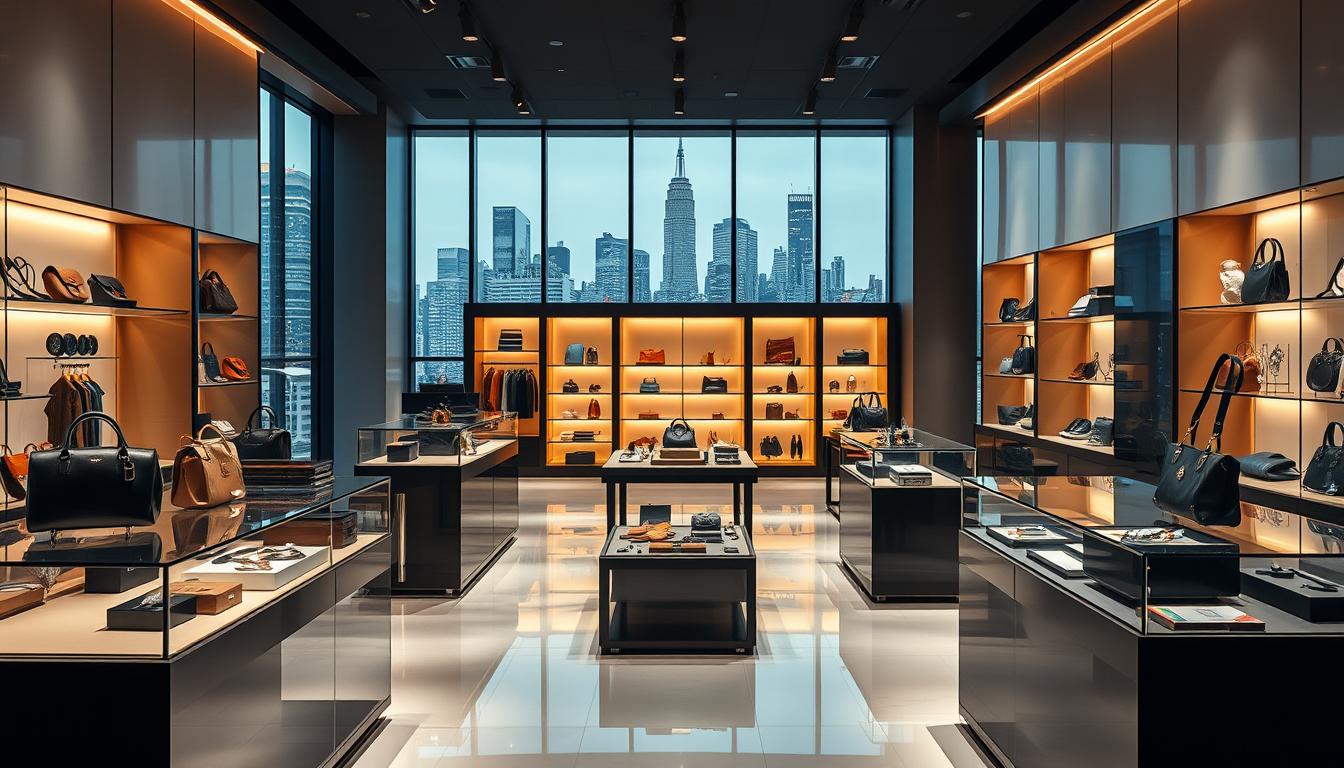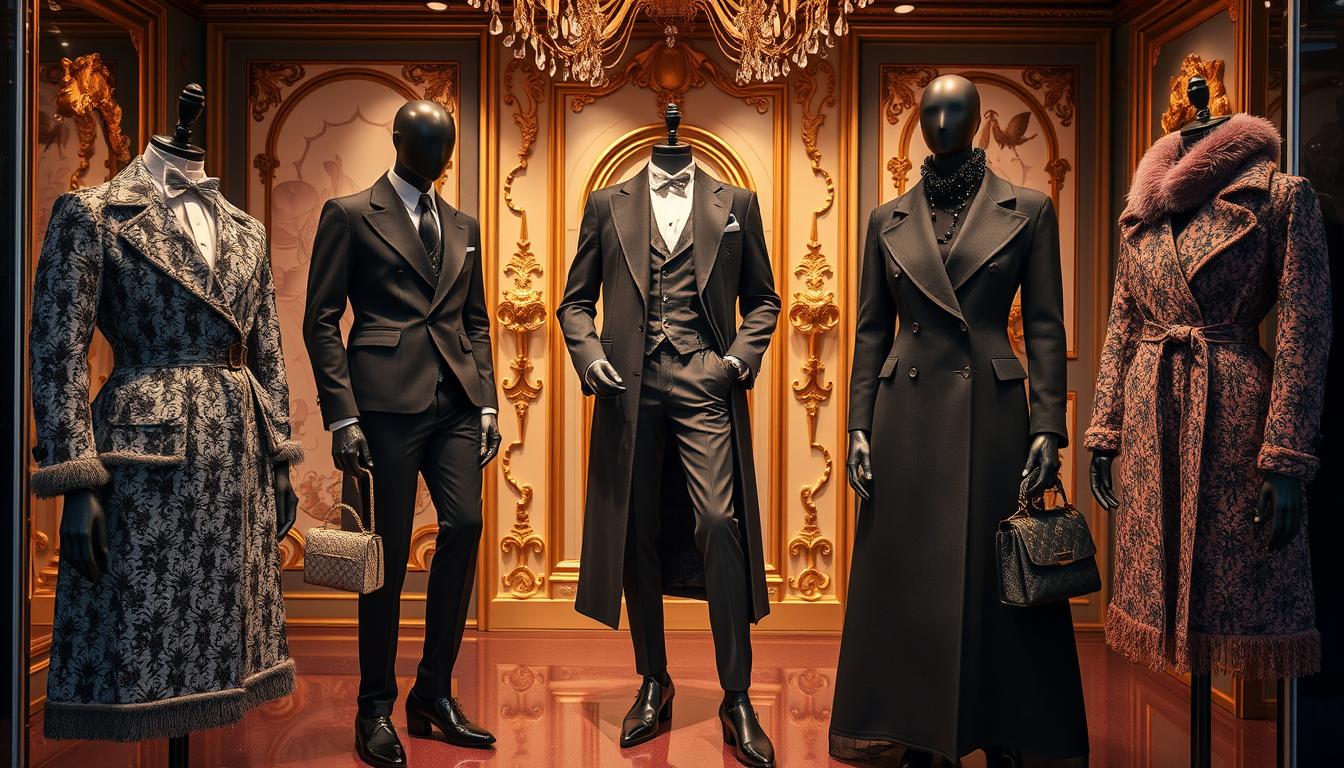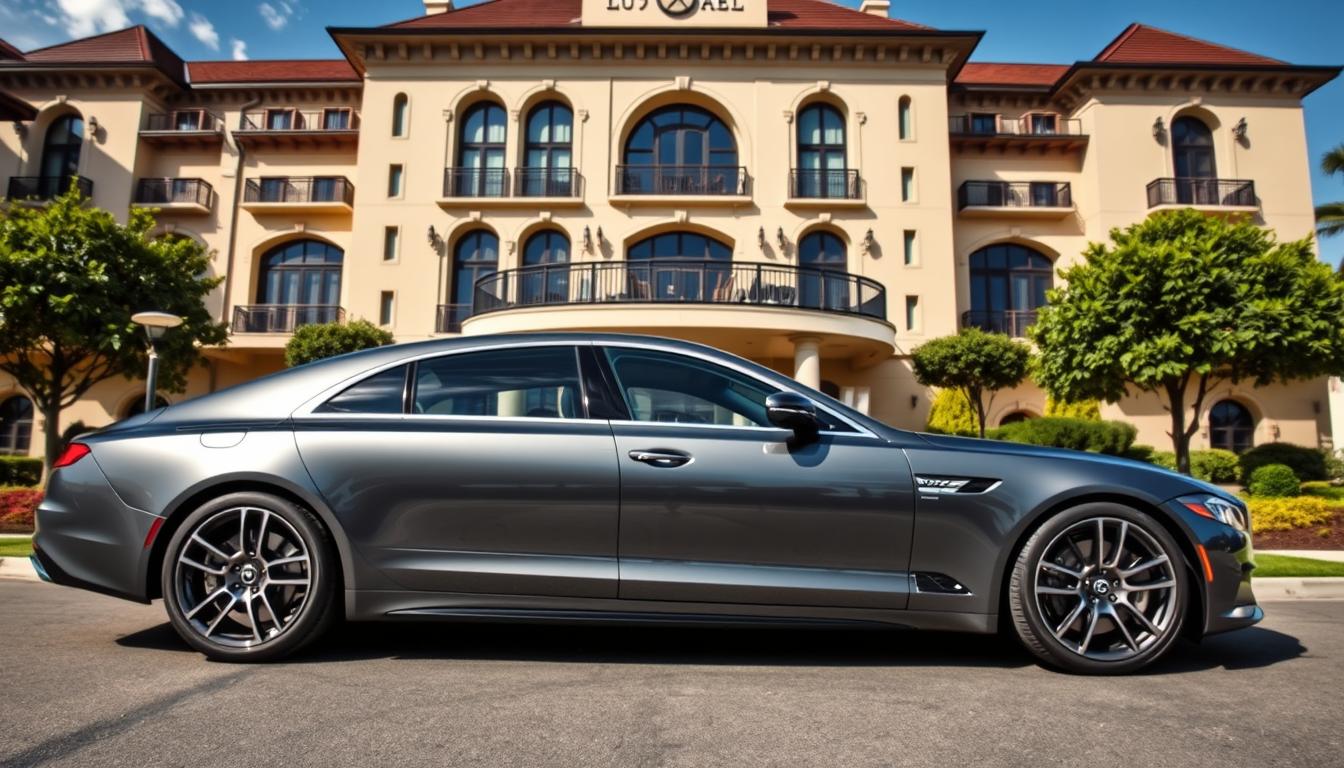In a world where craftsmanship meets prestige, luxury brands stand as beacons of opulence, elegance, and sophistication. We’re about to take you on an exclusive journey through the realm of these esteemed brands, showcasing the most prestigious names that define elegance and sophistication in today’s market.
These iconic fashion houses and sought-after beauty products, along with legendary hotels and resorts, captivate the imagination and set the standard for refinement across industries. At CoWrit Technologies, we’ve researched extensively to bring you the most accurate and compelling information about these leading brands, highlighting their rich heritage, impeccable craftsmanship, and unwavering commitment to quality.
Key Takeaways
- Discover the most prestigious luxury brands that define elegance and sophistication.
- Explore the rich heritage and craftsmanship behind these iconic brands.
- Learn about their innovative approaches and commitment to quality.
- Understand what makes these brands so coveted in the world of luxury.
- Gain expert insights into the luxury landscape from CoWrit Technologies.
The Allure and Significance of Luxury Brands
The world of luxury brands is a complex and multifaceted one, driven by a combination of exclusivity, craftsmanship, and prestige. Luxury brands represent the pinnacle of quality and exclusivity in the consumer market, shaping consumer behavior, influencing trends, and driving economic growth.
What Defines True Luxury in Today’s Market
Luxury brands are defined by several key characteristics, including exclusivity, heritage and tradition, superior quality, iconic design, prestigious image, exceptional service, and price premium. These elements combine to create brands that transcend ordinary consumer goods.
We examine how these factors contribute to the luxury brand experience. For instance, exclusivity is a hallmark of luxury, with brands like Hermès creating desirability through limited availability.
| Characteristic | Description | Example |
|---|---|---|
| Exclusivity | Limited availability creates desirability | Hermès Birkin Bags |
| Heritage and Tradition | Rich history and cultural significance | Louis Vuitton’s Monogram Pattern |
| Superior Quality | High-grade materials and craftsmanship | Rolex Watches |
The Economic Impact of Luxury Brands
Luxury brands contribute significantly to the global economy through their sales, employment opportunities, and investments. They often represent flagship industries in their respective countries, generating substantial revenue.
The economic impact extends beyond sales figures, as these brands drive innovation and create employment across multiple sectors.
The Top Luxury Brands in the Industry

The top luxury brands in the world are characterized by their rich heritage, exceptional quality, and the ability to evoke a sense of exclusivity. These brands, ranging from legendary fashion houses to prestigious automobile manufacturers, embody the epitome of excellence and craftsmanship.
According to Brand Directory, the top 10 luxury brands include Porsche, Louis Vuitton, Chanel, Gucci, Hermès, Dior, Cartier, Rolex, Tiffany & Co, and Ferrari. Other notable luxury brands are Giorgio Armani, Four Seasons, Yves Saint Laurent, Hugo Boss, Aman Resorts, Estee Lauder, Bottega Veneta, Omega, and Lamborghini.
How Luxury Brands Maintain Their Prestige
Luxury brands maintain their prestige through a combination of strategies that focus on quality, exclusivity, and emotional connection. By limiting production and controlling distribution, these brands create a sense of scarcity that enhances their allure.
Strategic pricing also plays a crucial role, as high prices can reinforce the perception of exclusivity and high quality. Moreover, luxury brands leverage their heritage and history to create an emotional connection with consumers, making their products not just items of desire but also symbols of status and sophistication.
The Role of Heritage and Exclusivity
Heritage is a cornerstone of luxury branding, as it provides a narrative that connects the brand to its past while highlighting its continued relevance in the present. Exclusivity is equally important, as it makes luxury products desirable by limiting their availability.
By balancing the need to expand their market reach with the necessity of maintaining brand integrity, luxury brands can ensure their continued success. This delicate balance involves careful consideration of marketing strategies, product distribution, and brand communication to preserve the sense of exclusivity that defines luxury.
LVMH: The World’s Largest Luxury Empire
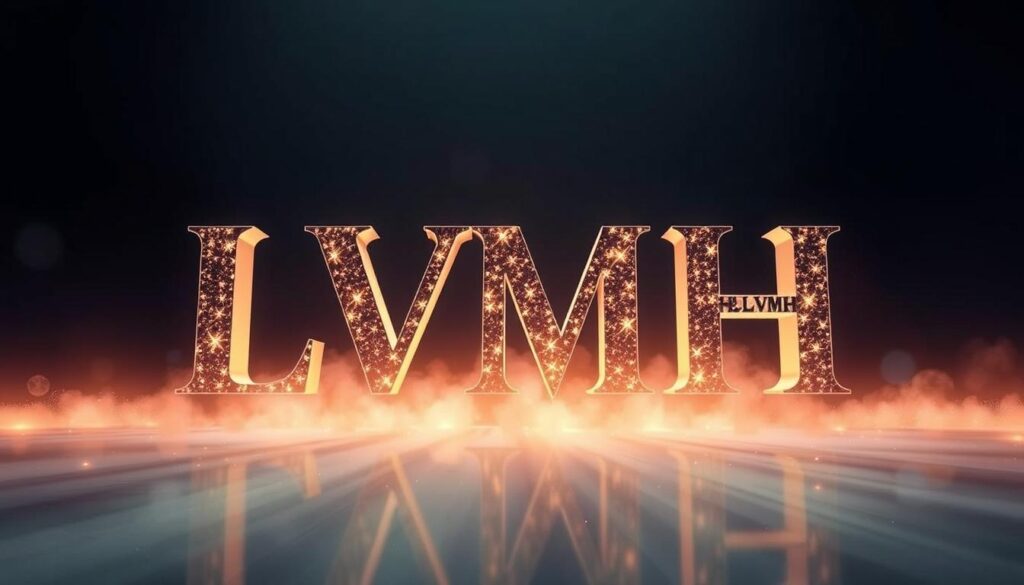
LVMH stands as a behemoth in the luxury goods sector, redefining the boundaries of high-end fashion and lifestyle. With a diverse portfolio of 75 prestigious brands, LVMH is a global leader in the luxury market.
The group’s operational scale is remarkable, with revenues reaching €79.2 billion in 2022, operating over 5,600 stores globally, and employing more than 196,000 people. This extensive reach underscores LVMH’s dominance in the luxury goods market.
Louis Vuitton: The Cornerstone of Luxury Fashion
Louis Vuitton is the most valuable brand within the LVMH portfolio, contributing approximately one-third of the group’s total sales and half of its profits. Its success can be attributed to its iconic monogram pattern and its ability to evolve while maintaining its prestigious status.
Louis Vuitton has managed to attract younger consumers through strategic collaborations and innovative product lines, ensuring its continued relevance in the ever-changing fashion landscape.
Dior, Fendi, and Other LVMH Powerhouses
Beyond Louis Vuitton, LVMH’s portfolio includes other iconic brands such as Christian Dior, known for its revolutionary designs, and Fendi, celebrated for its bold and eclectic style. These fashion houses contribute significantly to LVMH’s success.
The LVMH group’s ability to manage its diverse portfolio, allowing each brand to maintain its unique identity while benefiting from the group’s vast resources, is a key factor in its success in the global market.
Chanel: Timeless Elegance and Innovation
![]()
For over a century, Chanel has been at the forefront of fashion, revolutionizing women’s style with its innovative designs. This French fashion house was founded by Coco Chanel, and the brand is celebrated for its iconic designs, including the classic Chanel suit, quilted handbags, and little black dress.
The Revolutionary Vision of Coco Chanel
Coco Chanel’s vision was to liberate women from restrictive clothing, introducing a new concept of casual elegance. She achieved this by incorporating masculine elements into women’s fashion, such as shoulder bags and yachting pants. This radical departure from the norm continues to influence designers today.
Chanel’s Most Coveted Products
Chanel’s iconic designs have become enduring symbols of sophistication and style. Some of the most coveted products include the little black dress, Chanel No. 5 perfume, and the 2.55 quilted handbag. These products embody the luxury and quality that Chanel is known for, showcasing exceptional craftsmanship.
The brand‘s ability to balance tradition with innovation has been crucial to its continued success. Under the guidance of creative directors like Karl Lagerfeld, Chanel has evolved while maintaining its core aesthetic and values. Today, Chanel continues to set trends in luxury fashion while honoring its heritage.
Hermès: The Epitome of Craftsmanship and Exclusivity
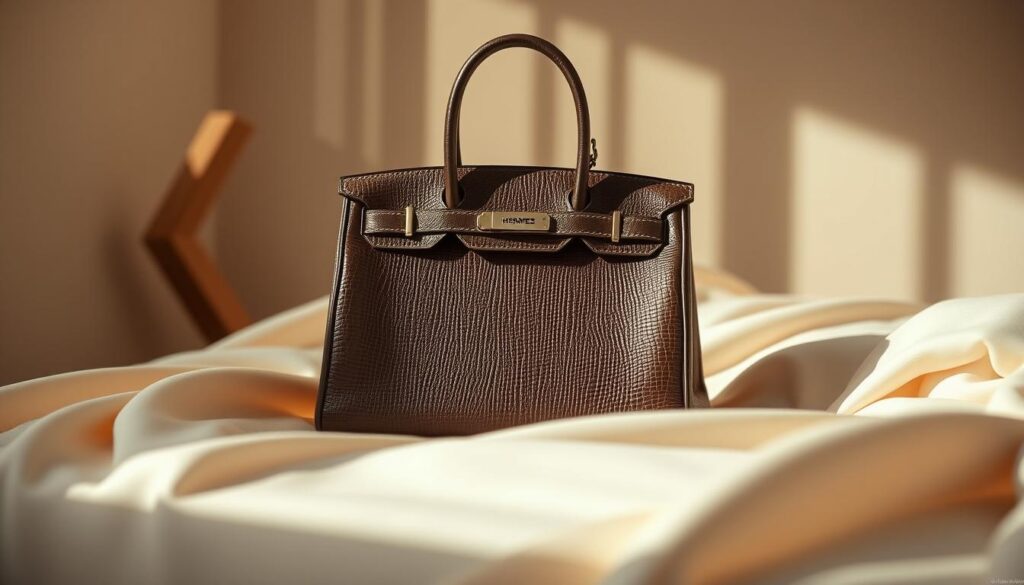
With a history spanning over 180 years, Hermès has evolved into a symbol of luxury and exclusivity. Founded in 1837 as a harness workshop in Paris, Hermès has grown into a global luxury brand, renowned for its commitment to quality and craftsmanship. The brand’s extensive range of products includes leather goods, lifestyle accessories, home furnishings, perfumery, jewelry, watches, and ready-to-wear.
Hermès is particularly celebrated for its iconic handbags, which embody the brand’s heritage and dedication to quality craftsmanship. The Birkin and Kelly bags are not only the brand’s most coveted products but also epitomize the luxury and exclusivity that Hermès represents.
The Legendary Birkin and Kelly Bags
The Birkin and Kelly bags are the pinnacle of luxury handbags, with their origins rooted in chance encounters and a deep understanding of what defines true luxury. The Birkin bag, for instance, was created following a conversation between Jane Birkin and Jean-Louis Dumas, the then-CEO of Hermès, on a flight. This serendipitous meeting led to the development of one of the most sought-after handbags in the world.
These handcrafted masterpieces are renowned for their exceptional quality and the meticulous attention to detail that goes into their creation. Each bag is handmade by a single artisan, a process that requires years of training and mastery. The result is a product that is not only a testament to Hermès’ craftsmanship but also a piece of art that appreciates over time.
How Hermès Maintains Its Exclusive Appeal
Hermès maintains its exclusive appeal through a combination of limited production, high-quality materials, and a commitment to traditional craftsmanship. By controlling all aspects of production in-house, Hermès ensures that every product meets its stringent quality standards. This approach, coupled with a conscious decision to limit supply, fosters an aura of exclusivity around its products.
The brand’s strategy extends beyond production to the purchasing experience, creating a unique and personalized journey for its clientele. This not only enhances the desirability of Hermès products but also reinforces the brand’s luxury status in the market.
Gucci and the Kering Group: Redefining Luxury for Modern Consumers
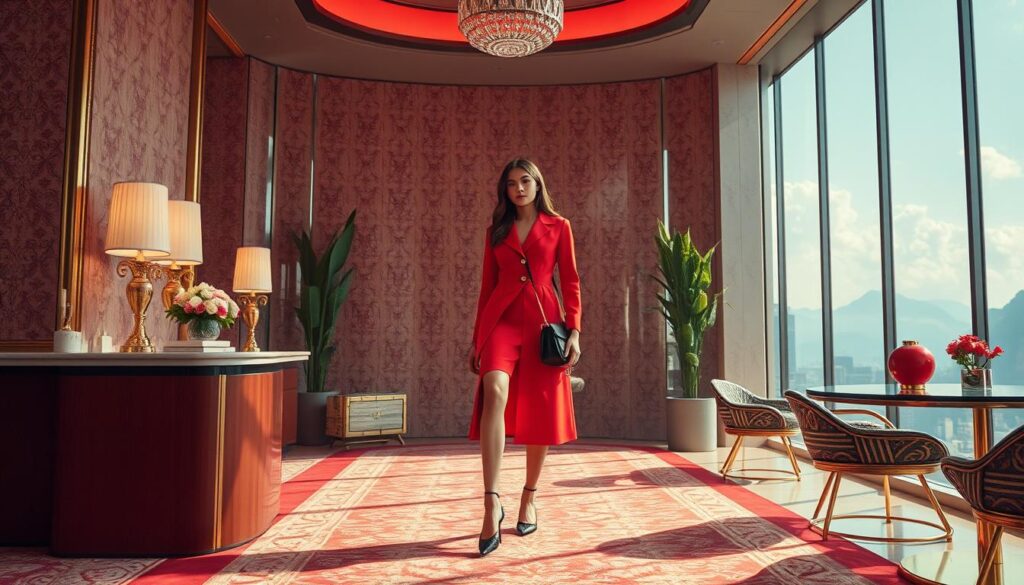
Gucci, a flagship brand of the Kering Group, has successfully redefined luxury, appealing to a new generation of consumers. Under the ownership of Kering, Gucci has managed to balance its rich heritage with modern trends, making it one of the most influential luxury fashion brands today.
Gucci’s Renaissance Under Alessandro Michele and Beyond
Gucci’s remarkable turnaround under the creative direction of Alessandro Michele was a pivotal moment for the brand. Michele’s bold and eclectic designs transformed Gucci into a powerhouse of fashion, attracting a younger demographic and significantly boosting the brand’s revenue.
Gucci’s appeal to Gen Z and millennials, who are predicted to make up 40% of the luxury market by 2035, is a testament to its successful rebranding. The brand’s ability to evolve while maintaining its heritage has been key to its success.
Balenciaga, Saint Laurent, and Bottega Veneta: Kering’s Other Stars
The Kering Group’s portfolio includes other notable brands such as Balenciaga, Saint Laurent (formerly Yves Saint Laurent), and Bottega Veneta. Each of these fashion houses brings a unique identity to the group.
Balenciaga has been a pioneer in luxury streetwear, pushing boundaries with its innovative designs. Saint Laurent continues to embody the revolutionary spirit of its founder, Yves Saint Laurent. Meanwhile, Bottega Veneta’s “stealth wealth” approach focuses on exceptional craftsmanship rather than overt branding.
Iconic Jewelry and Watch Brands
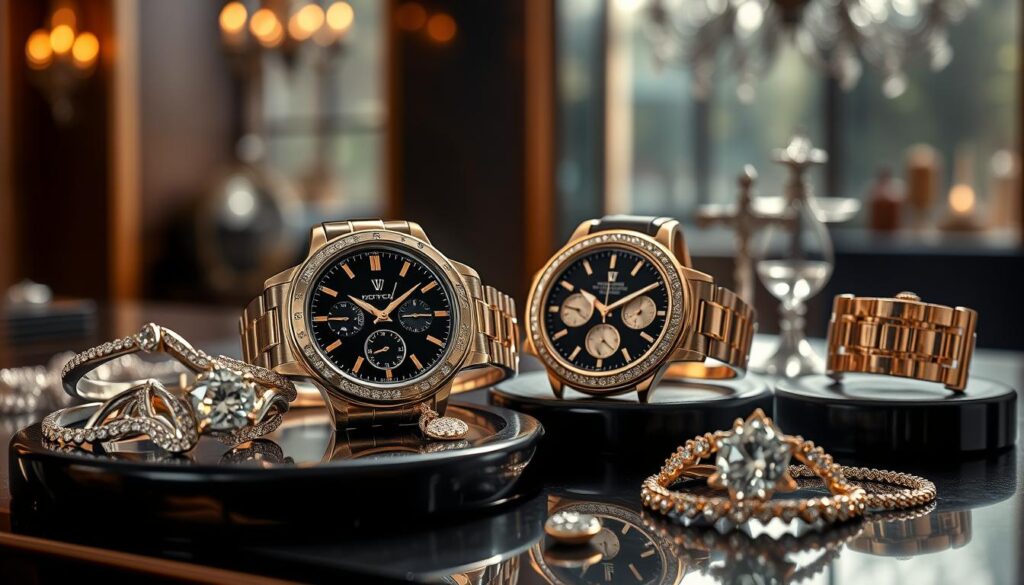
Elevating the art of luxury, iconic jewelry and watch brands continue to captivate connoisseurs worldwide with their unparalleled craftsmanship. These prestigious brands have not only defined the standards of quality and elegance but have also become integral to the world of luxury.
Cartier and Tiffany & Co: Masters of Luxury Jewelry
Cartier, founded in Paris in 1847, has earned its reputation as “the jeweler of kings and the king of jewelers.” Cartier’s iconic designs, such as the Love bracelet and Tank watch, continue to captivate luxury consumers worldwide. Tiffany & Co, established in New York City in 1837, has become synonymous with timeless elegance and romance.
Tiffany & Co’s distinctive blue box has become as iconic as the jewelry it contains. The brand has maintained its position as a global symbol of luxury through its commitment to impeccable craftsmanship.
Rolex and Richemont’s Watchmaking Excellence
Rolex is synonymous with precision, performance, and prestige in the world of watches. With a heritage dating back over a century, Rolex timepieces are renowned for their timeless design and technical innovation.
The Richemont Group, which owns prestigious watch brands like Jaeger-LeCoultre, IWC Schaffhausen, and Panerai, represents a powerhouse in the luxury watch industry. These brands maintain their distinctive identities while benefiting from shared expertise.
As we explore these iconic jewelry and watch brands, it becomes evident that their success lies in their ability to balance tradition and innovation. By honoring their heritage while embracing new technologies and design approaches, these brands continue to thrive in the ever-evolving luxury market.
Luxury Automotive Legends
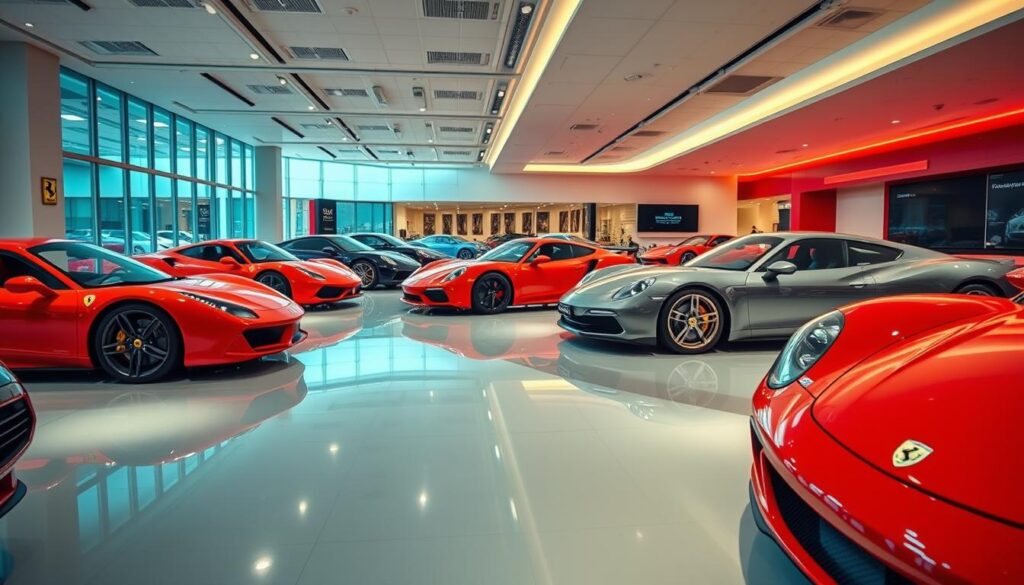
The world of luxury automotive brands is a realm where engineering excellence converges with artistic design. We explore the fascinating world of luxury automotive brands, where vehicles represent the ultimate expression of personal achievement and taste.
Two brands stand out in this exclusive club: Ferrari and Porsche. Ferrari stands as the pinnacle of automotive exclusivity, maintaining its position through deliberately limited production, creating a situation where demand far exceeds supply.
Ferrari: The Pinnacle of Automotive Exclusivity
Ferrari, an icon of automotive excellence and luxury, is celebrated not only for its contributions to motorsports but also for its exclusive line of luxury road vehicles. The company’s waiting lists for new cars are growing daily, with models like the Purosangue SUV having waitlists extending up to three years.
This exclusivity enhances Ferrari’s prestige, positioning it as the “Hermès of the automotive world,” creating products that increase in value over time and become coveted collectors’ items.
Porsche: Engineering Excellence and Brand Prestige
Porsche represents a different but equally successful approach to luxury automotive branding, balancing performance, innovation, and heritage. The brand has successfully expanded its product range beyond sports cars to include SUVs and electric vehicles while maintaining its reputation for engineering excellence and driving dynamics.
The contrast between Ferrari and Porsche reveals different approaches to luxury branding, with Ferrari emphasizing extreme exclusivity and Porsche focusing on accessible excellence and innovation. Both strategies have contributed to their brand prestige in the world of luxury automotive legends.
Luxury Beauty and Fragrance Houses

In the world of luxury beauty and fragrance, science and artistry converge to create exceptional products. We explore how these high-end brands are redefining the beauty industry through their commitment to quality, innovation, and exclusivity.
Estée Lauder and Its Luxury Portfolio
Estée Lauder, founded in 1946, is a pioneer in the luxury beauty industry. The brand started with just four skincare products and expanded into makeup, fragrance, and hair care. Estée Lauder is known for its high-quality, luxury products that cater to all skin types and tones. The company’s innovative approach, such as introducing the world’s first-ever serum, Advanced Night Repair, has set new standards in the industry.
Iconic Luxury Fragrances
Iconic luxury fragrances are some of the most recognizable and enduring luxury products. Brands like Chanel No. 5 have become legendary, with Marilyn Monroe famously claiming it was all she wore to bed. These fragrances not only represent a scent but also embody the essence of luxury and sophistication.
We analyze how luxury beauty brands balance scientific innovation with artistic presentation, creating products that deliver results while providing a sensory experience that justifies their premium pricing. The luxury beauty market continues to evolve, with established houses adapting to new challenges from clean beauty brands and changing consumer preferences.
How to Identify Authentic Luxury Products
In the world of luxury, authenticity is paramount, and distinguishing genuine products from counterfeits is a challenge we’re committed to helping you overcome. The luxury market is increasingly saturated with sophisticated counterfeit goods, making it essential for consumers to be vigilant when making a purchase.
Luxury brands invest heavily in ensuring their products are of the highest quality, using premium materials and exceptional craftsmanship. Genuine luxury items exhibit telltale signs of this quality, from precise stitching patterns to the weight and finish of the hardware.
Telltale Signs of Genuine Luxury Items
When examining a luxury product, there are several key details to look for to verify its authenticity. First, inspect the quality of the materials used. Luxury brands are known for their attention to detail and commitment to using only the finest materials. Check for any signs of poor craftsmanship, such as uneven stitching or misaligned patterns.
Luxury brands also often incorporate subtle authentication features into their products. These can include holographic tags, serial numbers, and proprietary materials or manufacturing techniques. For example, Louis Vuitton, part of the LVMH group, is known for its iconic designs and strict quality control, making it one of the most counterfeited brands in the world.
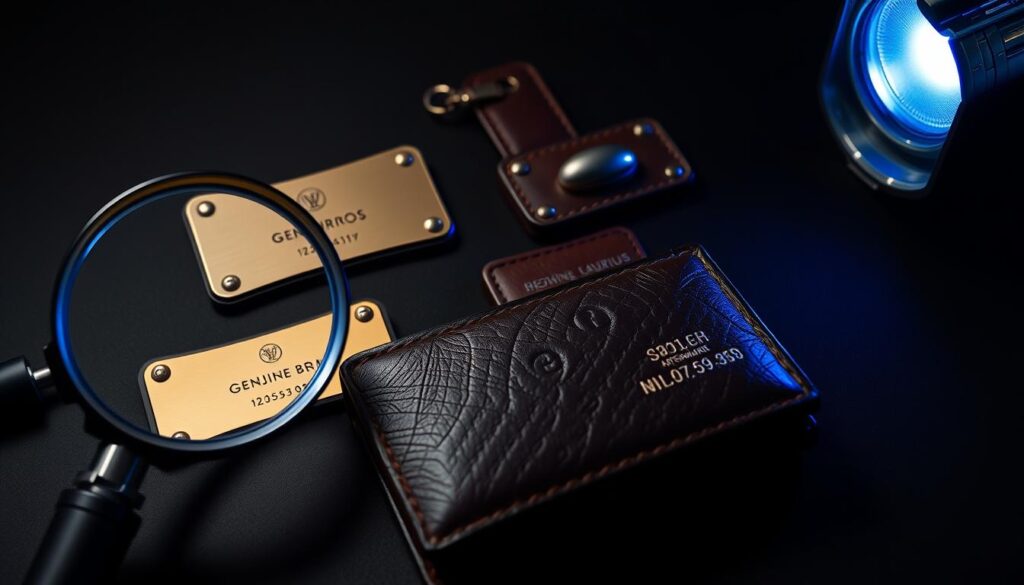
The Problem of Counterfeits in the Luxury Market
The problem of counterfeits in the luxury market has grown exponentially with globalization and e-commerce. Certain brands, like Louis Vuitton, have become particularly targeted due to their iconic designs, limited supply, and strict “NO SALE” policy. Counterfeiting not only affects the brand’s revenue but also has serious ethical implications, including links to organized crime, labor exploitation, and environmental damage.
Understanding the value chain of authentic luxury products helps explain their pricing. Factors such as material sourcing, artisan craftsmanship, design innovation, and brand investment all contribute to the final cost. By educating consumers on what to look for, we can help them make informed purchasing decisions and avoid counterfeit goods.
To shop safely for luxury items, consumers should stick to authorized retailers, consider authentication services, and explore the growing market for certified pre-owned luxury goods. The digital authentication revolution, including technologies like blockchain verification and digital passports, is also making it more difficult for counterfeiters to succeed.
The Future of Luxury: Digital Transformation and Sustainability
The future of luxury is being shaped by two major forces: digital transformation and sustainability. As the luxury industry continues to evolve, brands are leveraging technology and eco-friendly practices to redefine the luxury experience. This shift is not only changing how luxury brands operate but also how they connect with their consumers and maintain their brand equity.
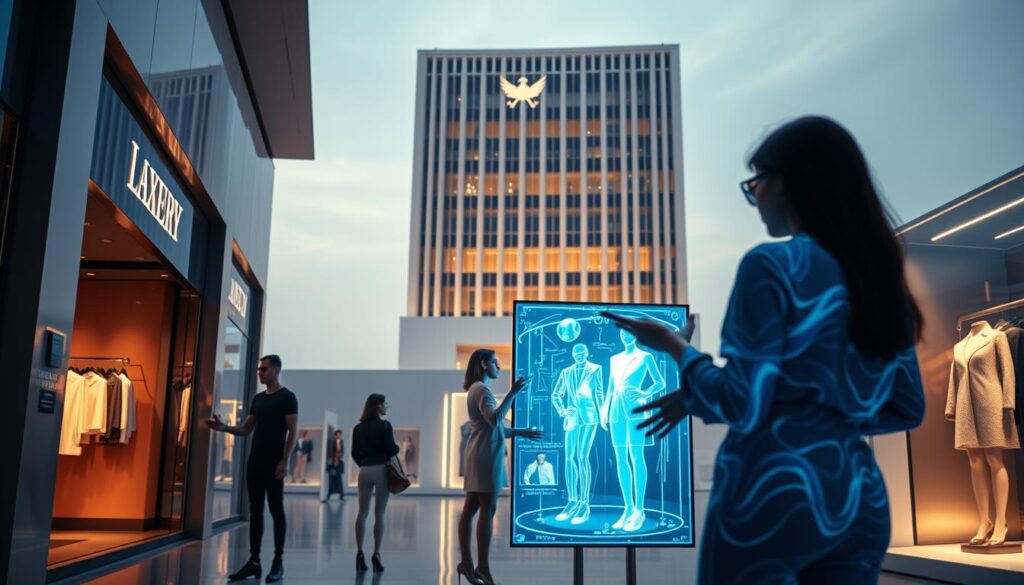
Embracing Digital Transformation
Luxury brands are navigating the digital revolution by adopting e-commerce platforms that preserve their exclusivity and personal touch. Houses like Louis Vuitton and Gucci have successfully created online shopping environments that maintain their brand prestige. Beyond e-commerce, innovative digital strategies are being explored, such as Balenciaga’s collaborations with e-sports platforms like Fortnite, pushing the boundaries of digital fashion.
The metaverse and digital fashion present both opportunities and challenges for luxury brands. Virtual products and experiences are likely to complement physical luxury goods, offering new avenues for brand expression and consumer engagement.
| Luxury Brand | Digital Initiative | Impact |
|---|---|---|
| Louis Vuitton | E-commerce platform | Preserved brand exclusivity online |
| Balenciaga | Fortnite collaboration | Innovative digital fashion experience |
| Gucci | Interactive online experiences | Enhanced consumer engagement |
Sustainable Luxury: The New Standard of Excellence
Sustainability has become a cornerstone of luxury excellence. Brands are reimagining their supply chains, material sourcing, and production methods to align with environmental values. Hermès is experimenting with mushroom leather, while Gucci has committed to carbon neutrality, and Burberry has pledged to eliminate plastic packaging.
The tension between traditional luxury materials and sustainable practices is being addressed through innovation. Luxury brands are adapting their messaging and practices to remain relevant while staying true to their heritage, ensuring that sustainability becomes synonymous with luxury excellence.
Conclusion: The Enduring Appeal of Luxury Brands
Our journey through the realm of top luxury brands reveals a consistent thread – an unwavering commitment to quality and excellence. We’ve explored the world of leading luxury brands, from the fashion powerhouses of LVMH and Kering to the watchmaking excellence of Rolex and the automotive legends Ferrari and Porsche.
The enduring appeal of these luxury brands lies in their perfect balance of heritage and innovation. They respect traditions of craftsmanship while continuously evolving to meet changing consumer desires. Whether through a meticulously crafted Hermès Birkin bag, a precision-engineered Rolex timepiece, or the unmistakable silhouette of a Ferrari, luxury brands offer tangible expressions of human excellence and artistic vision.
As we look to the future, luxury brands face new challenges in sustainability, digital transformation, and changing consumer values. Yet, the most prestigious houses are already demonstrating their ability to adapt while preserving their essential character. For those seeking to understand or enter the world of luxury, the brands we’ve explored represent not just commercial enterprises but cultural institutions that have shaped our understanding of quality, beauty, and excellence.
At CoWrit Technologies Inc, we specialize in creating compelling content that captures the essence of luxury brands and communicates their unique value to discerning audiences. Contact us via WhatsApp at +44-7822010953 to discuss how our services can elevate your luxury brand communications.
